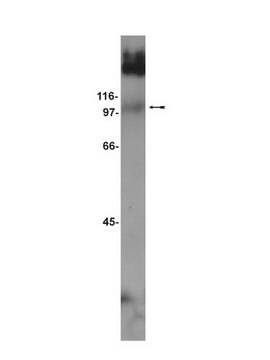MAB5204
Anti-Agrin Antibody
Chemicon®, from mouse
Synonym(s):
Anti-AGRIN, Anti-CMSPPD
Sign Into View Organizational & Contract Pricing
All Photos(1)
About This Item
UNSPSC Code:
12352203
eCl@ss:
32160702
NACRES:
NA.41
Recommended Products
biological source
mouse
Quality Level
antibody form
purified immunoglobulin
antibody product type
primary antibodies
clone
monoclonal
species reactivity
mouse, rat
manufacturer/tradename
Chemicon®
technique(s)
immunocytochemistry: suitable
western blot: suitable
isotype
IgG1
NCBI accession no.
UniProt accession no.
shipped in
dry ice
target post-translational modification
unmodified
Gene Information
human ... AGRN(375790)
Specificity
MAB5204 recognizes rat and mouse agrin. The epitope has been mapped near the splicing site Z. Binding of this antibody to agrin causes marked reduction in nAChR clusters.
Immunogen
Recombinant rat agrin (C-terminal construct)
Application
Anti-Agrin Antibody is an antibody against Agrin for use in WB & IC.
Immunocytochemistry: 10 μg/mL
Optimal working dilutions must be determined by the end user.
Optimal working dilutions must be determined by the end user.
Research Category
Neuroscience
Neuroscience
Research Sub Category
Growth Cones & Axon Guidance
Synapse & Synaptic Biology
Growth Cones & Axon Guidance
Synapse & Synaptic Biology
Physical form
Format: Purified
Purified immunoglobulin. Liquid in PBS containing 50% glycerol and 0.09% sodium azide.
Storage and Stability
Maintain lyophilized at material -20°C or below for up to 12 months. After reconstitution maintain at -20°C to -70°C in undiluted aliquots for up to 6 months. Avoid repeated freeze/thaw cycles.
Other Notes
Concentration: Please refer to the Certificate of Analysis for the lot-specific concentration.
Legal Information
CHEMICON is a registered trademark of Merck KGaA, Darmstadt, Germany
Disclaimer
Unless otherwise stated in our catalog or other company documentation accompanying the product(s), our products are intended for research use only and are not to be used for any other purpose, which includes but is not limited to, unauthorized commercial uses, in vitro diagnostic uses, ex vivo or in vivo therapeutic uses or any type of consumption or application to humans or animals.
Not finding the right product?
Try our Product Selector Tool.
Storage Class
10 - Combustible liquids
wgk_germany
WGK 2
Certificates of Analysis (COA)
Search for Certificates of Analysis (COA) by entering the products Lot/Batch Number. Lot and Batch Numbers can be found on a product’s label following the words ‘Lot’ or ‘Batch’.
Already Own This Product?
Find documentation for the products that you have recently purchased in the Document Library.
The COOH-terminal domain of agrin signals via a synaptic receptor in central nervous system neurons.
Hoover, CL; Hilgenberg, LG; Smith, MA
The Journal of cell biology null
Jinping Zhang et al.
FASEB journal : official publication of the Federation of American Societies for Experimental Biology, 20(1), 50-58 (2006-01-06)
It is well established that agrin, an extracellular matrix protein, plays a crucial role in the formation of neuromuscular junctions. Recent evidence indicates that agrin also contributes to immunological synapse formation. However, little is known about how agrin induces the
Hisashi Narai et al.
Neurology international, 1(1), e16-e16 (2009-01-01)
The transgenic animals with mutant copper/zinc superoxide dismutase (SOD1) DNA develop paralytic motor neuron disease resembling human amyotrophic lateral sclerosis (ALS) patients and are commonly used as models for ALS. In the transgenic (Tg) mice with the G93A mutation of
Syndecan-4 is associated with beta-cells in the pancreas and the MIN6 beta-cell line.
Jennifer Y C Cheng,John Whitelock,Laura Poole-Warren
Histochemistry and Cell Biology null
Nandor Nagy et al.
Development (Cambridge, England), 145(9) (2018-04-22)
The enteric nervous system (ENS) arises from neural crest cells that migrate, proliferate, and differentiate into enteric neurons and glia within the intestinal wall. Many extracellular matrix (ECM) components are present in the embryonic gut, but their role in regulating
Our team of scientists has experience in all areas of research including Life Science, Material Science, Chemical Synthesis, Chromatography, Analytical and many others.
Contact Technical Service







